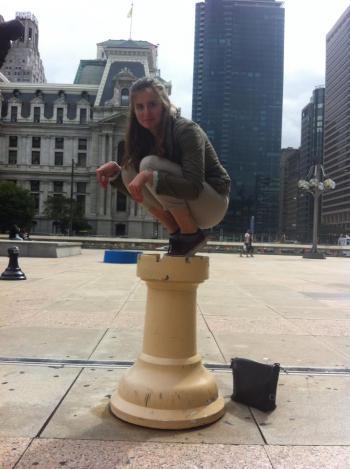Serendip is an independent site partnering with faculty at multiple colleges and universities around the world. Happy exploring!
Jiggly Philly


When momma and I stayed in Philly for Admitted Student Day in April, we were taken aback at how the banking district lived side-by-side with streets that almost looked like a ghetto. I told her I was feeling exceedingly pale and female. However by the end of our trip, we concluded that Philly is what it is and we appreciated it. This opinion has not changed. Whilst playing in it with Ellen and Samantha, I found myself looking for run-down establishments and homeless people near the Rodin Museum, as if the scene is incomplete without them. When we were messing around on the giant monopoly pieces near the municipal building, Sam commented on how the city hall does not fit in with the rest of Philly. I agree with her; its majestic white marble put the surrounding skyscrapers to shame.
And yet, these observations support the thesis in my previous paper. Philly is a concentration of American culture. This means that the facets of Philly are not supposed to necessarily compliment each other, but only to coexist silently. For example, I told Ellen that I felt like we were in Paris whilst strolling down the parkway. As soon as we stepped off it onto the Free Library Green, we were back in ‘Murica. Not just anywhere in ‘Murica, but in Washington DC. Washington DC likes to use lots of pillars like the ones at the Free Library; methinks it makes the elites feel more powerful.
Although, my own vision of what I think to be a city has been jiggled. As a rule, Geneva does not have a building taller than half the height of St. Pierre’s cathedral. So when I looked up and saw the towering skyscrapers with barely a street’s width of elbow room between them, I was reminded that modern cities build big or don’t build at all. I saw the congregation of homeless near the library. They were stoic, silent, and carried all their possessions in a few garbage bags. I suddenly felt guilty that I was wearing a small pair of sapphire earrings. Back home, I never saw the homeless population because they all hid in the ghetto behind the train station; the police were given the power to arrest them for begging. All this to say that my perception of an urban area has been injected with suffering and vertigo.
I’d be lying if I was thinking about Simmel whilst perched on a chess piece. Thanks to my conference with Anne, I now understand that Simmel and I share the same opinion of cities. He states “the psychological foundation...is the intensification of emotional life due to the swift and continuous shift of external and internal stimuli.” (11). My trip definitely supports this. I could almost feel my brain expanding and broadening with my changing perspectives. I could also feel it imploding when I explored the Asian market in Chinatown with my roommate later that evening (this was because I found a tea that apparently can enlarge your mammaries). When Simmel asserts that we become indifferent or “blasé - in which the nerves reveal their final possibility of adjusting themselves to the content and the form of metropolitan life by renouncing their response to them.” (14). Here is where I respectfully disagree. In my experience in both in Philly and Geneva, I have yet to get used to their respective beauties and stimuli. Maybe it’s because I’ve never lived in an urban area, but I think my ovaries will dry up sooner than I’ll stop marveling at city hall or bowing my head to the homeless. Each encounter with a city is a fresh one. I hope this never changes with age or frequency.


